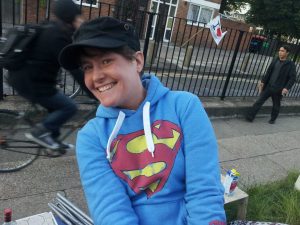
Nat Thorne
If you aren’t trans yourself, it can sometimes feel like you are walking on eggshells when talking to a trans person. What if you accidentally say something in all innocence that is actually deeply offensive? How can you negotiate the endless labels and pronouns and get it right? Well, just by understanding a few concepts and words, you can negotiate trans issues a lot more easily and probably gain a bit of understanding too. With that in mind, here are a few terms that can help you be a better trans ally.
Gender/Sex – So this first term is one that will make everything clear and really help you get to grips with what it means to be trans. Yes, normally (although not always) we are born with either a thingy or do-dah, with XX or XY chromosomes and all that other biological stuff which splits us into boys and girls. This is our sex, not our gender. Gender is all the other stuff which, essentially, we have created. For example in the West, a skirt is a female item of clothing. Pink is a female colour. Blue is a boy’s colour. Football is mostly a male pursuit. Craft is mostly a female one. Etc… The things we have created that don’t directly relate to our bodies is our gender. For most of us, we are born a certain sex and our gender matches – we enjoy all the stuff related to our gender. For many transgender people, there is not a match. When this miss-match occurs, some trans people choose to change the way they express their gender to match how they feel inside. Others also require surgery to change their bodies too. The key message here is that it is important to know that gender is something different to sex. Gender is something society has created and perpetuated for many years while sex is a biological thing.
Assigned male/female at birth – So, gender is something that on the whole is socially created, and the whole process starts at birth – blue for boys, pink for girls (in fact, this colour assignment in itself was only created around the 1940s!) So when a baby is born, we either dress them in pink and give them dolls, or dress them in blue and give them toy cars. We are ‘assigning’ them a gender by giving them lessons in how to be a boy or a girl. So when talking about a trans person’s gender, rather than saying they were ‘born male’ or ‘born female’ we say they were assigned male/female at birth. A trans person always had a gender identity of their own, it’s just to begin with, somebody else decided what that gender was based on the child’s sex.
Cis – Short for cisgender, this is a term which basically means a person whose gender matches their sex. This is the vast majority of the population. This term should be used instead of referring to non-trans people as ‘normal’. By calling one group normal, you instantly stigmatise those who don’t fall into that group, so try to use this word to describe those who feel a sense of unity with the body and gender they were given at birth. Chances are if you don’t identify as trans, then you are cis gendered.
Trans man/Trans woman – These terms often cause confusion. Basically if somebody was assigned male at birth but now identifies as female, they are a trans woman. If they were assigned female at birth but now identify as a man, they are a trans man. The key to remembering is that on the whole, we try not to refer to the trans person’s past. This means their current gender is their gender. Ignore what they were born or brought up with, their gender is what they are now.
Non-binary/Genderqueer – Definitely the ‘new kid on the block’ when it comes to gender identities, this one can be a little hard to get your head around. As mentioned, gender and sex are generally considered two distinct things, and so it makes sense that there may be people who either identify with both roles, more strongly with one than the other, or for some, neither. And let’s face it, what else in life (other than Marmite) dividends a whole population neatly into two groups? Many people struggle with the idea of somebody not being male or female, but that’s because it goes against everything we have been taught from day one. It’s always best to just get to know the person and try to respect their chosen pronoun.
Non-gendered Pronouns – A pronoun is normally a gendered word we use in a sentence, such as ‘he is going home now’ or ‘she is just arriving’. There is also a non-binary pronoun – they, which people often assume is ‘incorrect’. In fact, the pronoun they has been used for centuries and it is correct to use it in a sentence, even when referring to one person. In fact, non-gendered pronouns used to be the norm many years ago. As it isn’t in use that much in recent years, it might be hard to get your head around. But more and more trans persons prefer a non-binary pronoun these days, so do try. If you make a mistake, say sorry and correct yourself. Sounds like a lot of work but 1) it isn’t and 2) it’s just being polite! In the future, the singular ‘they’ will be used more and more, so as language changes, it should become easier to remember.
Gendered Pronouns – If in any doubt, it is always best to ask somebody their preferred pronoun. Most transmen and transwomen are clearly presenting in their gender rather than their assigned gender. Yes, you may have identified somebody was assigned male at birth, but if they are clearly identifying as female, then use she/her pronouns. The height of rudeness is to call a trans person by their gender assigned at birth and to be frank, it doesn’t take much thought to realise this is incorrect. Oh, and never use ‘it’. That is what we call inanimate objects. If you are really in a panic, just ask politely what their preferred pronoun is.
The main way you can avoid offence when meeting a trans person is just to respect them and respect their gender. When you think about it, we don’t talk much about our gender in everyday life when we meet a new person, we just get to know each other.
For more information, check out glaad.org/transgender/allies
Nat Thorne is a researcher from the University of Nottingham specialising in non-binary gender identities. Nat has identified as transgender for many years and is currently working on projects with The Nottingham Centre for Transgender Health and the Institute for Mental Health and is funded by CLAHRC East Midlands.

